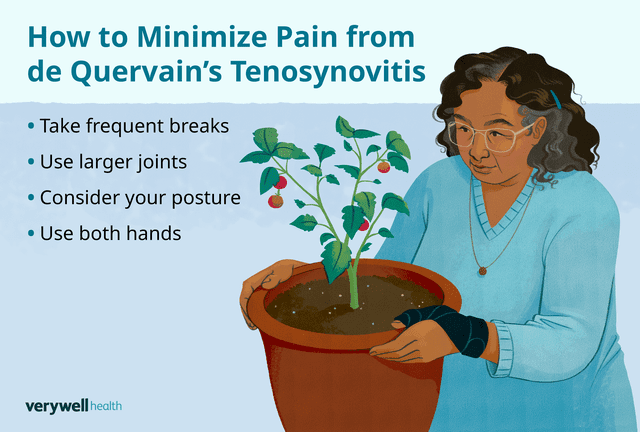De Quervain's Tenosynovitis: Conservative Management and Surgical Treatment
Medically reviewed by Theresa Marko, PT, DPT, MS
De Quervain's tenosynovitis (also called de Quervain's disease) is a condition that affects tendons that attach to two muscles of the thumb—extensor pollicis brevis and abductor pollicis longus. This condition typically develops from repetitive use of the thumb for activities such as twisting and pinching, but the cause is not always known.
This article discusses de Quervain's tenosynovitis causes and triggers, what the condition feels like, how to manage the condition at home, medical treatment, and recovery time.

Illustration by Mira Norian for Verywell Health
Symptoms: Describing de Quervain's Tenosynovitis Pain
The primary symptom of de Quervain's tenosynovitis is pain along the outer edge of the wrist and thumb, with use of the thumb tendons that are affected. These tendons lift the thumb up (the hitchhiking position) and out to the side (like you're grabbing a cup). Swelling can also occur.
Some people might feel a snapping or catching sensation with thumb movement and experience stiffness. A fluid-filled sac (cyst) can also develop.
Diagnosing de Quervain's Tenosynovitis
A simple test—the Finkelstein test—which is performed as follows, can help determine if a person has de Quervain's tenosynovitis:
Make a fist with the thumb tucked under the fingers.
Tilt the wrist toward the pinky side of the hand (like using a hammer). If there is pain along the thumb side of the wrist, the test is considered positive.
An X-ray might also be performed to rule out thumb arthritis, which can cause similar symptoms.
Treatment to Heal from de Quervain's Tenosynovitis
Treatment for de Quervain's tenosynovitis depends on the severity of the condition.
Home Management
Conservative treatment for de Quervain's begins with resting the affected tendons by wearing a thumb spica splint. This type of splint immobilizes the wrist and the thumb.
Ice and/or heat can also be applied to help reduce pain caused by de Quervain's tenosynovitis. Over-the-counter pain medications include nonsteroidal anti-inflammatory drugs (NSAIDs) such as Aleve (naproxen), Advil/Motrin (ibuprofen), or Bayer (aspirin), and pain relievers such as Tylenol (acetaminophen).
Hand therapy is also commonly used to treat de Quervain's tenosynovitis. This is often done by a certified hand therapist—an occupational therapist or physical therapist who specializes in the treatment of conditions that affect the hand and arm.
Hand therapy interventions for this condition can include:
Modalities for pain relief (such as ultrasound, electrical stimulation, cold laser therapy, and iontophoresis)
Range of motion and stretching exercises
Activity modification (learning new ways to do daily tasks that increase symptoms)
Manual techniques, such as massage
Prescribed Medications
Medications can help decrease pain and inflammation that can occur with de Quervain's tenosynovitis. OTC medications may be tried first.
Prescription-strength non-steroidal anti-inflammatory medications can also be used to treat de Quervain's tenosynovitis. These can be oral medications or topical creams that are rubbed into the skin over the affected tendons.
Examples include:
Celebrex (celecoxib)
Mobic (meloxicam)
Voltaren (diclofenac)
de Quervain's tenosynovitis is also treated with corticosteroid medication that is injected into the tendon sheath that holds the affected tendons in place.
Related: Celebrex vs. Mobic: Similarities & Differences
Surgery
Around 50% to 80% of cases of de Quervain's tenosynovitis improve with conservative treatment.
However, if symptoms do not improve with conservative treatment, surgery might be required. This procedure involves releasing the tendon sheath that holds the two involved tendons in place to relieve pressure on these structures.
Hand therapy is often prescribed for rehabilitation after de Quervain's tendon release surgery.
Recovery Time
Symptoms of de Quervain's tenosynovitis typically improve within four to six weeks of conservative treatment.
Recovery after de Quervain's tendon release surgery can take up to 12 weeks.
De Quervain's Tenosynovitis Injury: Causes and Triggers
De Quervain's tenosynovitis is often caused by repetitive hand and wrist motions (such as hammering, lifting children, and carrying heavy bags by their handles). It can also occur from direct injury to the thumb side of the wrist. However, the cause is not always known.
Certain factors can increase risk of developing this condition, such as:
Female sex
Age of 40 years or more
Previous wrist injury
Arthritis
De Quervain's tenosynovitis is also common during pregnancy and breastfeeding due to hormonal changes. For many people, the condition resolves on its own after childbirth or when breastfeeding stops.
How to Minimize Thumb to Wrist Pain
While de Quervain's tenosynovitis can't always be prevented, you can take steps to help decrease your risk of developing thumb-to-wrist pain.
Take frequent breaks: If you have a job that requires repetitive motions, such as using tools or typing, or hobbies, such as knitting or gardening, take a short break every 30 to 60 minutes and stretch your muscles.
Use larger joints: Loop bags over your forearm rather than gripping them with your hands.
Consider your posture: Make adjustments to your workstation—poor posture can put increased pressure on your wrists and hands while working at a desk.
Use both hands: Carry objects in both hands to balance the weight and avoid gripping bags by the handle.
Summary
De Quervain's tenosynovitis is a condition that affects tendons of the extensor pollicis brevis and abductor pollicis longus muscles that move the thumb. This condition causes pain and sometimes other symptoms such as swelling and snapping/catching of the tendon during movement.
The cause of this condition is not always known, but it often occurs with repetitive motion activities. Treatment for de Quervain's tenosynovitis includes medications, splinting, hand therapy, injections, and, less commonly, surgery.
Read the original article on Verywell Health.

